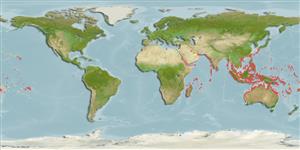Common names from other countries
>
Ovalentaria/misc (Various families in series Ovalentaria) >
Pomacentridae (Damselfishes) > Glyphisodontinae
Etymology: Abudefduf: Arabic, abu = father; this fish is the leader of the reef against other species (Ref. 45335).
More on author: Lacepède.
Environment: milieu / climate zone / εύρος βάθους / distribution range
Οικολογία
Θαλασσινό(ά) Υφαλόφιλο(α); μη μεταναστευτικό(ά); εύρος βάθους 1 - 20 m (Ref. 58652). Tropical; 33°N - 35°S, 32°E - 143°W (Ref. 56027)
Indo-Pacific: Red Sea to Pinda, Mozambique (Ref. 4391) and the Tuamoto Islands, north to southern Japan, south to Lord Howe and Rapa islands. Not recorded from the Hawaiian Islands.
Μέγεθος / Βάρος / Age
Γεννητική Ωρίμανση: Lm ? range ? - ? cm
Max length : 19.0 cm TL αρσενικό/απροσδιόριστο; (Ref. 90102)
Short description
Κλείδες προσδιορισμού | Μορφολογία | Μορφομετρία
Ραχιαίες άκανθες (συνολικά) : 13; Μαλακές ραχιαίες ακτίνες (συνολικά) : 12 - 16; Εδρικές άκανθες: 2; Μαλακές εδρικές ακτίνες: 12 - 14.
Body shape (shape guide): short and / or deep; Cross section: compressed.
Adults inhabit inshore and offshore coral or rocky reefs. Also in shallow coastal reef flats or crests, usually where lots of tall soft corals or hydroid colonies are present (Ref. 48636). Often found in groups feeding at midwater or tending nests among rocks and coral ledges (Ref. 90102). Feed on zooplankton and algae and aggregates high in the water column (Ref. 9710). Oviparous, distinct pairing during breeding (Ref. 205). Eggs are demersal and adhere to the substrate (Ref. 205). Males guard and aerate the eggs (Ref. 205).
Life cycle and mating behavior
Γεννητική Ωρίμανση | Αναπαραγωγή | Γεννοβολία | Αβγά | Γονιμότητα | Προνύμφες
Oviparous, distinct pairing during breeding (Ref. 205). Eggs are demersal and adhere to the substrate (Ref. 205). Males guard and aerate the eggs (Ref. 205), mostly deposited on rocks or dead corals (Ref. 128523). Males may manifest cannibalism occasionally (Ref. 128523).
Allen, G.R., 1991. Damselfishes of the world. Mergus Publishers, Melle, Germany. 271 p. (Ref. 7247)
IUCN Red List Status (Ref. 130435: Version 2025-1)
Threat to humans
Harmless
Human uses
αλιεία: περιορισμένης εμπορικότητας; Ενυδρείο: Δημόσια ενυδρεία
Εργαλεία
Special reports
Download XML
Διαδικτυακές πηγές
Estimates based on models
Preferred temperature (Αναφ.
123201): 24.7 - 29.3, mean 28.4 °C (based on 3258 cells).
Phylogenetic diversity index (Αναφ.
82804): PD
50 = 0.5000 [Uniqueness, from 0.5 = low to 2.0 = high].
Bayesian length-weight: a=0.02188 (0.01267 - 0.03777), b=3.10 (2.95 - 3.25), in cm total length, based on LWR estimates for this species & Genus-body shape (Ref.
93245).
Τροφικό Επίπεδο (Αναφ.
69278): 2.7 ±0.30 se; based on food items.
Ελαστικότητα (Αναφ.
120179): Μεσαίο(α), ελάχιστος χρόνος για διπλασιασμό πληθυσμού 1,4 - 4,4 έτη (Preliminary K or Fecundity.).
Fishing Vulnerability (Ref.
59153): Low vulnerability (10 of 100).
🛈
Nutrients (Ref.
124155): Calcium = 77.1 [39.9, 122.3] mg/100g; Iron = 0.654 [0.404, 1.051] mg/100g; Protein = 18.3 [17.1, 19.4] %; Omega3 = 0.0999 [, ] g/100g; Selenium = 24.3 [14.0, 44.7] μg/100g; VitaminA = 72.9 [20.5, 239.9] μg/100g; Zinc = 1.51 [1.05, 2.17] mg/100g (wet weight);
